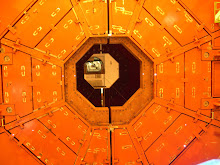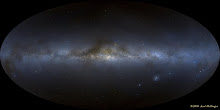Ordinarily magnet quenches occur when proton beams are lost or scatter into magnets, causing helium coolant and magnets to heat and lose their superconductivity and their power to keep proton beams within the collider. CERN doesn't say whether beams were running today during the accident. They would have been at their lowest power 0.45 TeV per beam, though beams 11 times more powerful at 5 TeV were scheduled before October 12th. Vacuum conditions were also lost said the BBC, which suggests beam damage, though CERN hasn't commented.
This is on top of another major failure to the helium cooling system. Last Friday the 12th's thunderstorm burned out a giant 30 tonne 12 Million Volt Amperes surface transformer that powers some of the helium cryogenics system. Although CERN admitted the problem yesterday, without mentioning the thunderstorm, and said the transformer was replaced last weekend, there was no explanation for the long delay in informing the public. The failure of the transformer caused an initial warming in the helium coolant in 2 of the colliders 8 sectors, some as late as September 17th at near 7 K
Whether an ongoing transformer problem contributed to quenching has not been announced. The TimesOnline initial report on damage said, "One of the beams had been captured by Friday, but work was then interrupted by the loss of electrical transformers that power the cryogenic cooling system . . ." A beam apparently running during the thunderstorm, and more than one transformer lost. CERNS's lastest progress report yesterday was sketchy.
The damaged Sector3-4, an eighth of the 17 mile collider has still not been stabilized since this morning's accident. About half of it or a mile length was well above normal 1.9 K design temperature, about a quarter of the sector and its magnets this afternoon at 15:46 PM were about 82 K to 110 K. Currently all magnets have warmed. The warmest show a slight recovery from 110 K down to 99 K. and Sector 3-4 is still in crisis as of the 20th September 0:418 AM, with no accurate readout for about half the magnets, and the rest showing more warming, with a few outside the spike zone climbing abruptly in temperature since this afternoon.
Given the gravity of the accident, repairs would take a week or longer.
References
BBC. "Hadron Collider forced to halt", Sept 19, 2008, BBC News, http://news.bbc.co.uk/1/hi/sci/tech/7626256.stm
CERN. "LHC progress report, week 1", Sept 18, 2008, LHC First Beam, http://lhc-first-beam.web.cern.ch/lhc-first-beam/News/lhc_080918.html
Gillis, Alan. "LHC Fails Thunderstorm Test", Sept 17,2008, The Science of Conundrums, http://bigsciencenews.blogspot.com/2008/09/lhc-fails-thunderstorm-test.html
Henderson, Mark. "'Big Bang Machine' back on collision course after its glitches are fixed", Sept 18, 2008, TimesOnline, http://www.timesonline.co.uk/tol/news/uk/science/article4774817.ece




























4 comments:
For the latest developments on this serious collider accident, see my article of today in my column on ScientificBlogging, http://www.scientificblogging.com/big_science_gambles/accident_forces_two_month_shutdown_at_the_large_hadron_collider_lhc
Actually, that's 100k, not degrees, according to sector3-4's very own page: http://hcc.web.cern.ch/hcc/cryo_main/cryo_main.php?region=Sector34
Otherwise, interesting blog, I love the descriptions of the worst case scenarios. :p
Do you think that a bosenova implosion had anything to do with it?
As far as 100 C temperature rise in magnets reported by the BBC, or 100 K used by CERN, in this case when working out a temperature difference, they're interchangable, both correct.
No on the Bosenova. CERN now says it was a superconducting busbar that melted. This is one of many interconnects between magnets. It seems it burned through two adjoining magnets that then ruptured a tonne of helium. Why it happened is another matter. No doubt CERN is wondering about that too.
Post a Comment